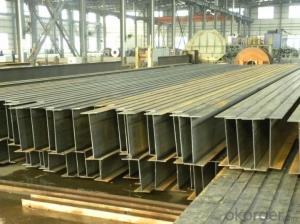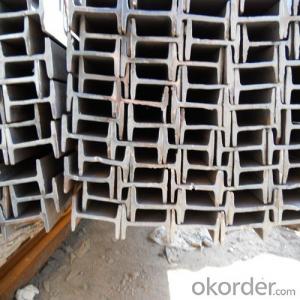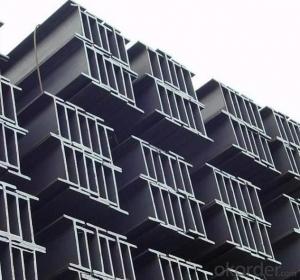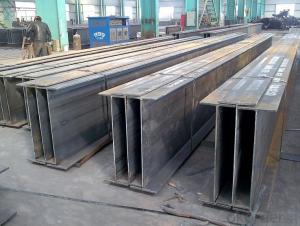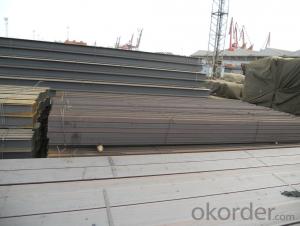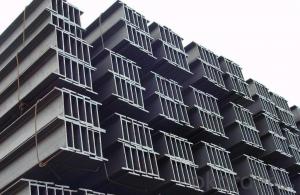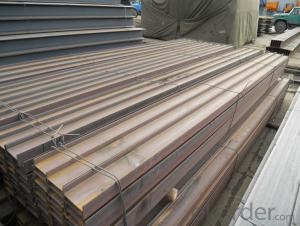Japanese Standard SS400 H beam with High Quality 388mm-400mm
- Loading Port:
- Tianjin
- Payment Terms:
- TT OR LC
- Min Order Qty:
- 100 m.t
- Supply Capability:
- 15000 m.t/month
OKorder Service Pledge
OKorder Financial Service
You Might Also Like
Specification
Specifications of Japanese Standard SS400 H beam with High Quality 388mm-400mm:
1. Standard: JIS 3192
2. Grade: SS400 or Equivalent
3. Length: 10m, 12m as following table
4. Invoicing on theoretical weight or actual weight as customer request
5.Payment: TT or L/C
Size and Mass of Japanese Standard SS400 H beam with High Quality 388mm-400mm:
| Size(mm) | Mass (Kg/m) | Size (mm) | Mass (Kg/m) |
| 400*200*8.0 | 65.4 | 388*402*15.0 | 140 |
| 390*300*10.0 | 105 | 394*398*11.0 | 147 |
Packaging & Delivery of Japanese Standard SS400 H beam with High Quality 388mm-400mm for Building Structures:
1. Packing: it is nude packed in bundles by steel wire rod
2. Bundle weight: not more than 3.5MT for bulk vessel; less than 3 MT for container load
3. Marks:
Color marking: There will be color marking on both end of the bundle for the cargo delivered by bulk vessel. That makes it easily to distinguish at the destination port.
Tag mark: there will be tag mark tied up on the bundles. The information usually including supplier logo and name, product name, made in China, shipping marks and other information request by the customer.
If loading by container the marking is not needed, but we will prepare it as customer request.
4. Transportation: the goods are delivered by truck from mill to loading port, the maximum quantity can be loaded is around 40MTs by each truck. If the order quantity cannot reach the full truck loaded, the transportation cost per ton will be little higher than full load.
5. Delivered by container or bulk vessel.
FAQ:
Q1: Why buy Materials & Equipment from OKorder.com?
A1: All products offered by OKorder.com are carefully selected from China's most reliable manufacturing enterprises. Through its ISO certifications, OKorder.com adheres to the highest standards and a commitment to supply chain safety and customer satisfaction.
Q2: How do we guarantee the quality of our products?
A2: We have established an advanced quality management system which conducts strict quality tests at every step, from raw materials to the final product. At the same time, we provide extensive follow-up service assurances as required.
Q3: How soon can we receive the product after purchase?
A3: Within three days of placing an order, we will arrange production. The shipping date is dependent upon the quatity, how many sizes you want and the plan of production, but is typically 1 month to 2 months from the beginning of production.
Images of Japanese Standard SS400 H beam with High Quality 388mm-400mm:
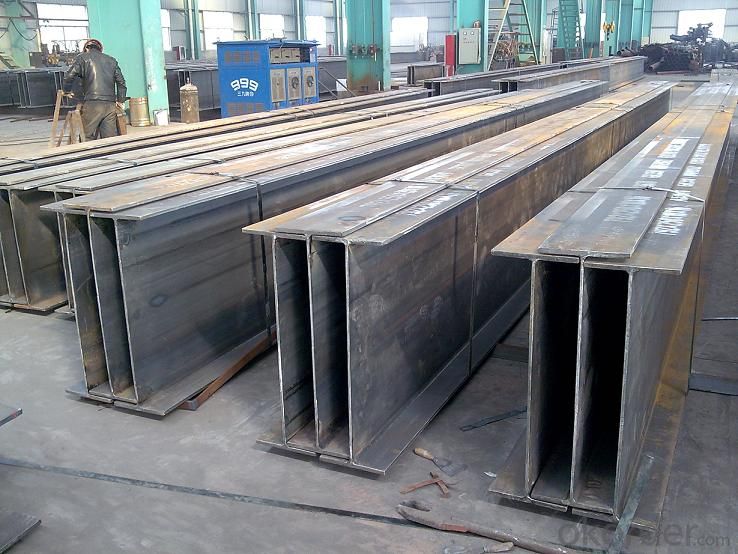
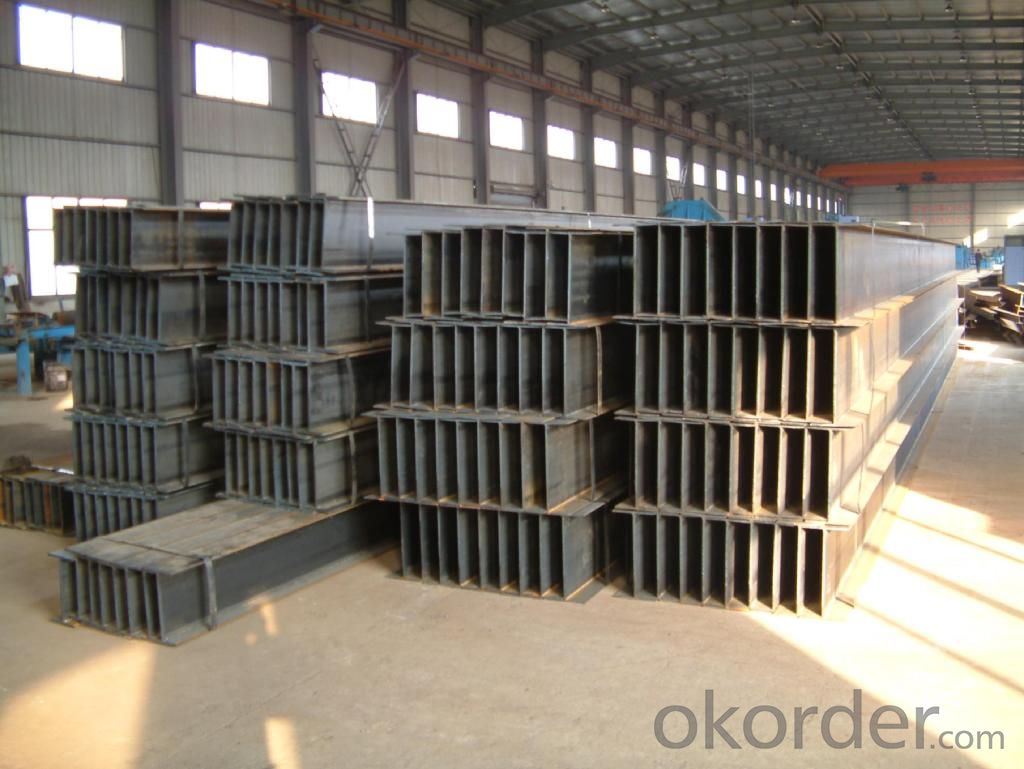
* If you would like to get our price, please inform us the size, standard/material and quantity. Thank you very much for your attention.
- Q: Are steel H-beams resistant to seismic forces?
- Yes, steel H-beams are generally resistant to seismic forces. Steel is a highly durable and strong material, making it suitable for withstanding seismic forces, such as those generated by earthquakes. H-beams, also known as I-beams, provide excellent structural support due to their shape, which distributes the load evenly along the beam's length. This shape helps to minimize the effects of seismic forces by effectively dissipating the energy and preventing excessive movement or deformation. Additionally, steel H-beams can be further reinforced with additional materials or techniques, such as cross-bracing or moment resisting frames, to enhance their seismic resistance even further. Therefore, steel H-beams are commonly used in construction projects located in earthquake-prone areas, as they offer a high level of resilience against seismic forces.
- Q: Are steel H-beams suitable for structures with high ceilings?
- Steel H-beams are indeed a suitable choice for structures that have high ceilings. Construction projects often rely on H-beams because of their impressive strength and ability to bear heavy loads. These beams are specifically designed to provide stability to the structure and support substantial weights. The unique H-shape of the beams enables them to efficiently distribute the weight, which makes them especially well-suited for structures with high ceilings that may experience heightened vertical loads. Moreover, steel H-beams possess durability and resistance against environmental factors like fire, moisture, and pests. Consequently, they are a dependable option for ensuring long-term structural integrity.
- Q: How do Steel H-Beams compare in terms of lifespan and durability?
- Steel H-Beams are known for their exceptional lifespan and durability. These structural members are specifically designed to withstand heavy loads and provide long-lasting support for various construction projects. The lifespan of steel H-Beams can be significantly longer compared to other building materials such as wood or concrete. One of the key factors contributing to their durability is the inherent strength of steel. H-Beams are made from high-quality steel, which has superior tensile strength and resistance to bending and twisting forces. This enables them to withstand extreme weather conditions, seismic activity, and other external factors that can cause damage to structures over time. Moreover, steel H-Beams are not susceptible to rot, decay, or insect infestations like wooden beams. They also do not degrade or weaken under moisture, which is a common issue with concrete structures. This makes steel H-Beams highly durable and reliable, ensuring their long-term performance and structural integrity. Additionally, steel H-Beams are resistant to fire, which further enhances their lifespan and durability. Steel has a high melting point and does not contribute fuel to a fire, making it a safer choice for structural elements. This characteristic is particularly important in high-rise buildings or structures where fire protection is a critical consideration. Furthermore, steel H-Beams can be easily inspected for any signs of wear or damage. Regular maintenance and inspections can help identify and address any issues promptly, ensuring the continued durability and longevity of these structural members. In conclusion, steel H-Beams have a remarkable lifespan and durability due to their high strength, resistance to environmental factors, and fire resistance. These qualities make them an excellent choice for a wide range of construction projects where longevity and structural integrity are paramount.
- Q: What are the different surface finishes available for steel H-beams?
- Steel H-beams come in various surface finishes, each with its own unique properties and advantages. Some commonly used surface finishes for steel H-beams include: 1. Mill finish: This is the standard finish straight from the steel mill. It has a slightly rough texture and may have minor imperfections. Mill finish is typically used for structural applications where appearance is not a priority. 2. Hot-dip galvanized: In this finish, the steel H-beam is immersed in molten zinc, creating a protective layer that prevents corrosion. Hot-dip galvanizing is commonly used for outdoor structures or applications exposed to harsh environments. 3. Painted: Steel H-beams can be coated with paint for both aesthetic and protective purposes. Painted finishes offer a wide range of color options and provide additional corrosion resistance. 4. Powder-coated: Powder coating is a durable and attractive finish applied electrostatically as a dry powder and cured under heat. It is resistant to chipping, scratching, and fading. 5. Primed: Priming involves applying a layer of primer to the steel H-beam before any additional finish is applied. Primers enhance adhesion of subsequent coatings and provide an extra layer of protection against corrosion. 6. Stainless steel: Instead of surface finishes, stainless steel H-beams are often left with a natural finish due to their inherent resistance to corrosion. The stainless steel material itself offers excellent durability and resistance to staining or rusting. When selecting a surface finish for steel H-beams, it is important to consider the specific application and environment. Factors such as durability, corrosion resistance, appearance, and cost will all influence the most suitable finish. Seeking guidance from a steel supplier or specialist can ensure the best choice for your specific needs.
- Q: What are the sustainability certifications for steel H-beams?
- There are several sustainability certifications for steel H-beams, including the Leadership in Energy and Environmental Design (LEED) certification, the Green Building Council's Green Star certification, and the International Organization for Standardization's ISO 14001 certification. These certifications ensure that the manufacturing and sourcing of steel H-beams meet environmentally-friendly standards and promote sustainable practices throughout the production process.
- Q: Can steel H-beams be painted or coated?
- Steel H-beams are capable of being painted or coated in order to protect them from corrosion, enhance their appearance, and increase their durability against damage. To ensure optimal adhesion, it is crucial to thoroughly clean and prepare the surface prior to painting or coating. The appropriate choice of paint or coating will vary depending on factors like environmental conditions and desired finish. It is advisable to seek advice from a professional or adhere to the manufacturer's instructions to guarantee the proper selection and application of the paint or coating.
- Q: What is the lifespan of steel H-beams?
- The lifespan of steel H-beams can vary depending on several factors such as the quality of the steel used, the conditions in which the beams are used, and the level of maintenance they receive. Generally, steel H-beams are designed to be durable and long-lasting, making them suitable for various structural applications. If properly manufactured and maintained, steel H-beams can have a lifespan of several decades or even longer. The high strength and structural integrity of steel allow it to withstand heavy loads, extreme weather conditions, and other external factors that can potentially degrade the material over time. However, it is important to note that various factors can contribute to the deterioration of steel H-beams. These factors include exposure to corrosive elements such as moisture, chemicals, and saltwater, as well as structural overload, excessive vibrations, and improper installation or handling. Regular inspections and maintenance are crucial to identify any signs of corrosion, fatigue, or structural damage that may affect the lifespan of the beams. In summary, the lifespan of steel H-beams can be extensive if they are well-manufactured, properly maintained, and used within their design limitations. By implementing appropriate maintenance practices and protecting the beams from adverse conditions, it is possible to extend their lifespan significantly.
- Q: How do steel H-beams distribute load?
- Load distribution is achieved by steel H-beams through the utilization of their distinctive structural shape and material properties. H-beams are characterized by a horizontal top and bottom flange, connected by a vertical web in the center. This design enables the efficient distribution of loads by transferring them from the top flange to the web and then to the bottom flange, resulting in a balanced distribution of forces throughout the beam. The top and bottom flanges of H-beams are wider and thicker than the web, providing greater resistance to bending and torsional forces. When a load is applied to the beam, the top flange undergoes compression while the bottom flange undergoes tension. This distribution of forces helps the H-beam withstand bending and prevents it from collapsing under the weight of the load. Additionally, the vertical web in the center of the H-beam enhances stability and rigidity. It effectively resists shear forces that may act on the beam, preventing twisting or buckling. By connecting the flanges, the web ensures an even distribution of the load along the entire length of the beam, avoiding concentration in specific areas. The steel material used in H-beams is also pivotal in load distribution. Steel is renowned for its high tensile strength and durability, making it an ideal choice for structural applications. The strength of steel enables H-beams to bear heavy loads without deforming or failing. Moreover, steel possesses excellent stiffness and elasticity properties, guaranteeing that the H-beam maintains its shape and structural integrity under various loads. In conclusion, steel H-beams distribute load effectively through their unique shape and material properties. The horizontal flanges resist bending and tension forces, while the vertical web enhances stability and prevents twisting. The combination of these factors ensures efficient load distribution and the overall structural integrity of the system.
- Q: 300*200h steel 7 meter span center load the most, can bearing 30 tons?
- H section steel belongs to middle wing H section steel, can weigh 30 tons. 294*200*9*12 of the national standard. According to the specifications of the calculation, 10 meters span is large, or the cross section of the beam is a bit small, only the strong or the equivalent of roof purlin. Can not bear too much weight. Recommend the use of H type steel above 600*300*12*18. Below is the H type steel bearing calculation:RA=RB=P/2 Mc=Mmax=Pl/4 fc=fmax=Pl^3/48EI A= B=Pl^2/16EI symbol and theta theta P - Q - N; concentrated load, uniform load, N; R - bearing force, the direction of the action is positive, N; M - bending moment, the compression of the upper section, lower tension is positive, Nm; Q, the shear. The adjacent section of the torque in a clockwise direction is positive, N; F, deflection, downward displacement is positive, mm; angle theta, clockwise rotation as positive degrees; E - Gpa; I - elastic modulus, cross-sectional moment of inertia, m^4; L = x/. =x'/l, zeta, alpha beta gamma = a/l, =b/l, =c/l from two aspects
- Q: Are steel H-beams suitable for structures with complex geometries?
- Steel H-beams are commonly used in construction due to their high strength-to-weight ratio and versatility. However, when it comes to structures with complex geometries, their suitability may depend on various factors. Firstly, steel H-beams are typically produced in standard sizes and shapes, which may not be ideal for structures with irregular or intricate geometries. In such cases, custom fabrication or additional structural elements might be required to adapt the H-beams to the complex geometry, which can increase costs and complicate the construction process. Secondly, steel H-beams are most effective in structures that require long-span support or need to withstand heavy loads. Their inherent strength and rigidity make them suitable for structures like bridges, warehouses, and high-rise buildings. However, for structures with complex geometries that do not necessarily require long-span support or heavy load-bearing capacity, alternative construction materials or structural systems might be more appropriate. That being said, steel H-beams can still be used in structures with complex geometries, especially when combined with other structural components or advanced engineering techniques. By incorporating additional beams, trusses, or bracing, it is possible to distribute loads more evenly and enhance the structural integrity of the complex geometry. In conclusion, while steel H-beams are a versatile choice for many construction projects, their suitability for structures with complex geometries may depend on the specific requirements and design constraints. Consulting with structural engineers and architects is crucial to determine the best approach and select the most suitable materials for such projects.
Send your message to us
Japanese Standard SS400 H beam with High Quality 388mm-400mm
- Loading Port:
- Tianjin
- Payment Terms:
- TT OR LC
- Min Order Qty:
- 100 m.t
- Supply Capability:
- 15000 m.t/month
OKorder Service Pledge
OKorder Financial Service
Similar products
Hot products
Hot Searches
Related keywords
